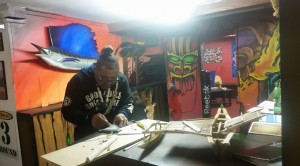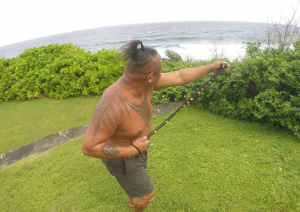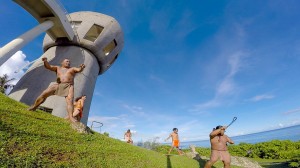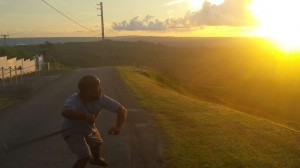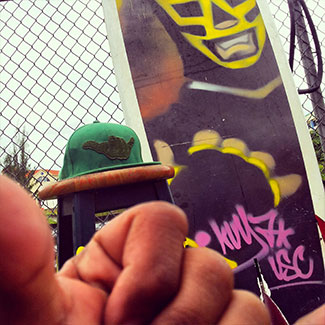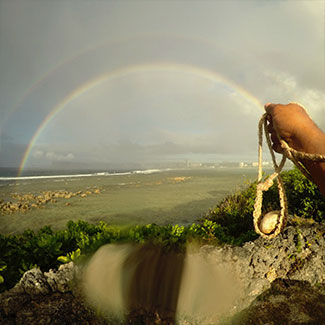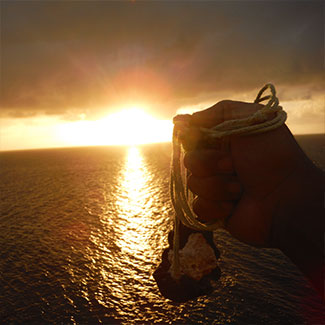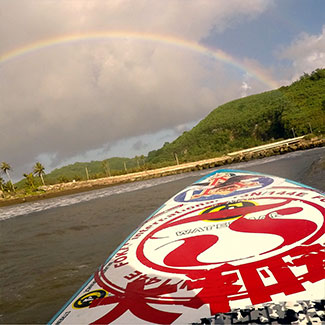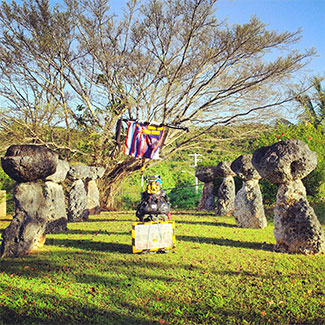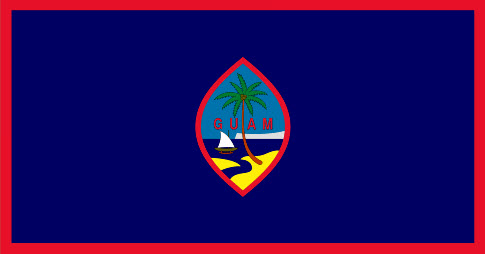Guelo! FOKAI IRELAND!
February 22, 2017 by admin
Filed under Special Forces
Guelu putting the final touches (at Fokai Ireland’s Grasshopper Lounge), on his model Proa hours before Fokai Amphibious Division, TASA, and The Guam Waterman Club’s ‘ presentation of The Flying Proa to Ireland Seafarers this evening at The Oar in Crosshaven Ireland
From POSTGUAM: Guamanians to compete in Spanish sling-stone competition
February 9, 2017 by admin
Filed under Special Forces
From POSTGUAM: Guamanians to compete in Spanish sling-stone competition
Article by Matt Weiss of The Post Guam
In March, a small three-man Guamanian contingent will be headed to Mallorca, Spain, to compete in an international sling-stone competition called the IV Encuentro Internacional Dia de les Illes Balears 2017. More than 20 nations from around the world will compete to see who has the most dead-on and distanced slingers. Guam’s slingers will consist of Roman Dela Cruz, Ben “Guelu” Rosario and Tony Piaulig.
While the original intention was to create a nationally recognized Guam team, Dela Cruz said, “A lack of time and busy schedules didn’t allow” it. While he admits there’s no way to know if they’re Guam’s best, they are, nonetheless, committed. “There’s no guarantee that we’re the best slingers on the island, but no doubt that we’re dedicated slingers and we’re putting in our practice time.”
Promoting culture through sport
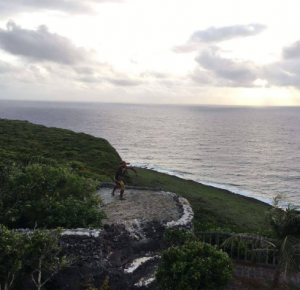 Hoping to see a resurgence in Guamanians paying respect to the ancient Chamorros, Dela Cruz explained why he and the team decided to get involved in the Spanish sling-stone competition: “Our venture of jumping it into sport is actually a path to revive slinging among our people and to connect them not just with slinging, but primarily into the interest, preservation and rejuvenation of other traditional practices as well.”
Hoping to see a resurgence in Guamanians paying respect to the ancient Chamorros, Dela Cruz explained why he and the team decided to get involved in the Spanish sling-stone competition: “Our venture of jumping it into sport is actually a path to revive slinging among our people and to connect them not just with slinging, but primarily into the interest, preservation and rejuvenation of other traditional practices as well.”
Having received an invitation from two-time slinging champion Sam Christian Wirk of Austria, the trio will be representing more than just Guam. “The three of us … will be venturing to Spain to represent not just the Chamorro people, but also to represent Micronesia.”
Dela Cruz said he’s been slinging stones for nearly eight years, Rosario’s been at it for more than 20 years, and Piaulig has been slinging since he was a child on the island of Palowat. With over 60 years of slinging experience between them, and with a little luck, they will weave their way through the bracket and represent Guam with honor and respect.
Skill improves with perseverance
Dela Cruz, the team’s spokesman shared some of the competition’s rules: “The object for the competition we’re aiming for is, for the most part, based on accuracy from increasing distances as you advance through the brackets.” He shared that only locally gathered tournament stones must be used and slings must be made from organic material. “Only slings of natural fibers are allowed, and the stones will be natural river stones from the area of the competition.”
Dela Cruz, the least experienced of the group, never thought he would progress in the sport as far as he has. “I thought I would never get anywhere with it. For almost three years, I couldn’t get it straight; I was convinced it was beyond me.” He said that men like Pat Ayuyu and Rosario helped him improve tremendously. “I have a great respect for them and I am thankful for them every day for keeping me on this journey.“
He offered some advice in parting: “I would love to encourage everyone to try slinging. With the right mindset, it can be incredibly invigorating, even enchanting, like the sword to the samurai.”
Origin Of Slinging And How The Ancient Chamorro People Used It
January 2, 2017 by admin
Filed under Special Forces
Origin Of Slinging And How The Ancient Chamorro People Used It
The sling was one of the first projectile weapons, creatively developed as early as 10,000 B.C. Slingers played a significant role in the Greek, Persian, Roman, and several Mesopotamian armies, and were also considered to be equal to or more better than archers.
However, it is used more expansively in Europe and the Middle East, the evidence of its use can clearly be found all over the world, with the remarkable exclusion of Australia.
There are various Pacific Island and Mediterranean cultures, which easily maintain solid slinging traditions till today through competitions and historical recreations.
The weapon was cheap and extremely easy to make. Vegetable fibers, plant fibers, animal hide, hair, and several other materials could successfully be used for the pouch and cords.
Unlike a bow, which strictly required specialist experience to produce, a sling could be made by anyone. The sling of the late Paleolithic is generally identical to the modern sling because the design is unique.
The main objective of innovation is the payload of the sling. Rivers stones were popular as their polished, smooth surface caused low air resistance angular rocks, which greatly improved the range and accuracy.
In addition, no matter how selectively these were collected, the shape of natural stones literally varies. This also meant the slinger had to compensate for switching projectile weights, reducing total accuracy. At the same time, Near Eastern armies began providing their slingers with uniform projectiles made from carved stone or baked-clay, at the end of the 7th B.C.
Initially, these were spherical, but by 3000 B.C, biconical projectiles were found to be superior. The last two types would orient point first and shoot in the air like a gun bullet or American football.
The signature weapons of the early Chamorro’s, numerous sizes of sling stones were grinded on both sides and forcefully thrown from a sling with great force in combative times. These stones, also called åcho atupak in the indigenous language of Chamorro, were derived through basalt, limestone, or fire-hardened clay and were hung from slings created from coconut fiber, the latter being far better by way of durability.
In historical texts, it is documented that the most successful part of these most oftentimes ovals shaped stones were that ancient Chamorro’s used them with deadly accuracy.
Though commonly related with weaponry of the Latte period, in early colonial history, these stones were used as the arms of resistance to the colonization of Spain, hurled at the harbingers of that particular destruction.
A prized art of warfare, the scope behind the hurling and fashioning of these stones were kept in the men’s domain and were handed over by older males to younger males, usually from father to his son.
The ancient people of Guam used spears and sling stones during war. The sling stones were football like in nature; Chamorro boys are expert throwers because they were trained since when they were very young.
The stones were thrown from a cord sling, the sling stone is fixed in a pocket at the middle of the sling, the stone is shut out by whipping the long cord of the sling.
In the origin of Guam’s sling technology, there are questions that have not been answered satisfactorily. Various archeologists have argued independent development of sling weaponry and possible introduction from the Philippines.
Fortunately, till today in the Philippines or other areas of Southeast Asia, no other technology has been identified. It is much more likely that, conceptually, Melanesia are the introducers of slings and football shaped sling stones.
Bismarck Archipelago would have been the best bet, which are islands located along the northeastern coast of New Guinea, sling stones has been dated to 2000-2300 years ago and 3100 years ago in the Bismarck and Santa Cruz-Reef Island.
Guelo Slinging Tutorial Capitol F (Acho Atupak) // The Fokai Shop Agana
September 12, 2016 by admin
Filed under Special Forces
Guelo Slinging Tutorial Capitol F (Acho Atupak) // The Fokai Shop Agana. How to use a Chamorro sling also known as Acho Atupak.

